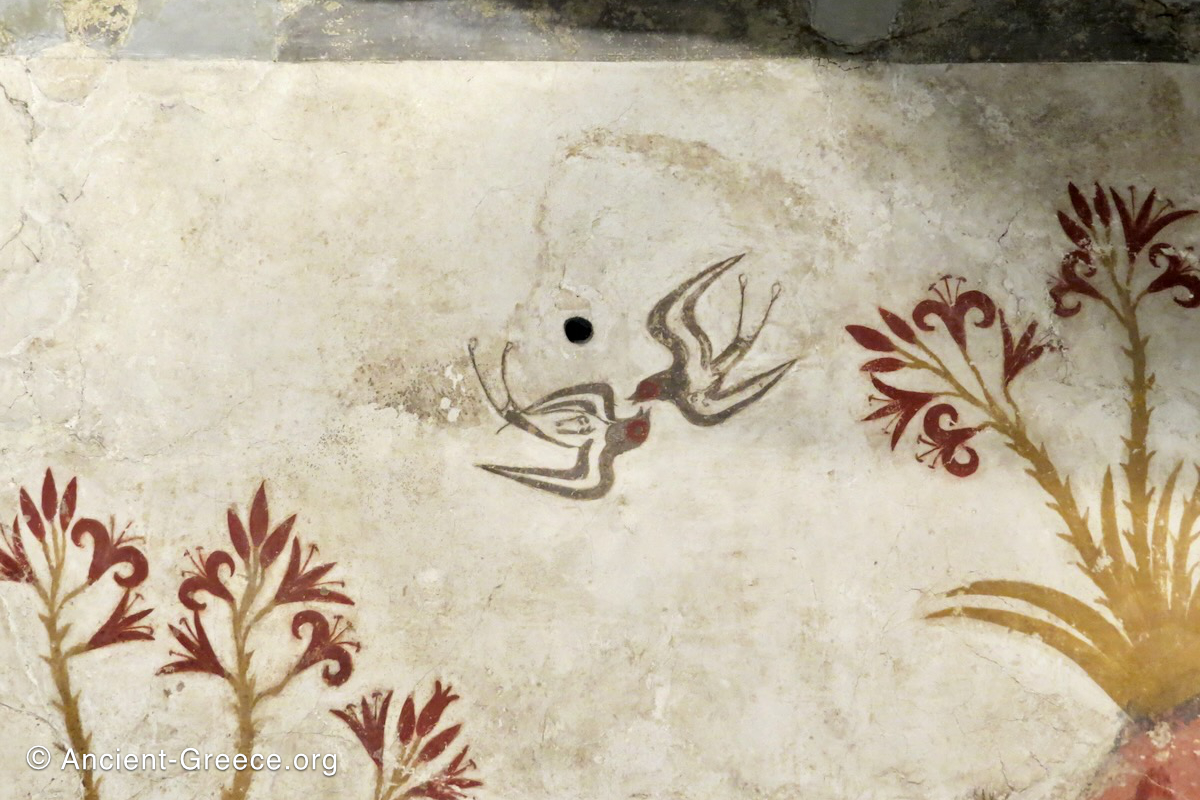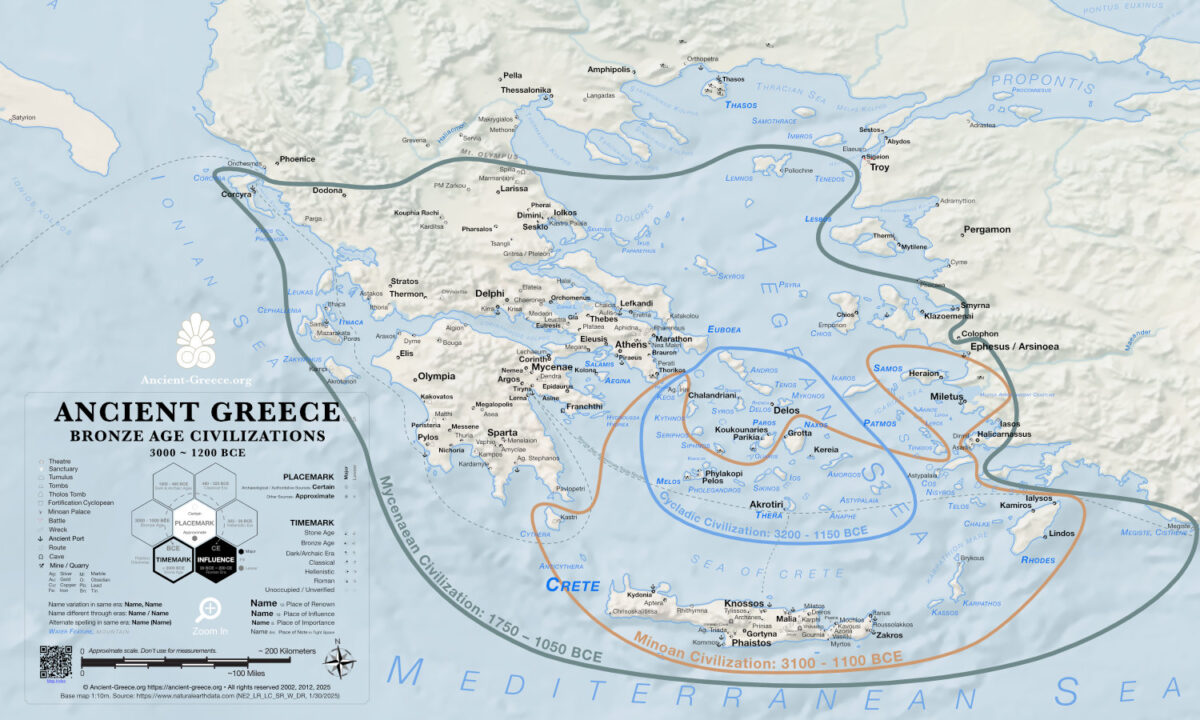
On this page:
The National Archaeological Museum in Athens exhibits some of the best examples of Neolithic and Bronze Age artifacts from the Aegean and Helladic civilizations found in excavations across the country.
Neolithic Era
Top row, left to right:
- Spherical ceramic vessel from Dimini. Late Neolithic I phase, 5300 – 4800 BCE.
- Illustration of life in the Neolithic Era and clay figurines from Dimini
Second row:
- Three Neolithic figurines, including a Late Neolithic (5300 – 4500 BCE) figurine of a female figure holding an infant.
- The Thinker.
A clay figurine found in Karditsa, in Thessaly, Greece. It is the largest Neolithic figurine found in Greece 4500 - 3300 BCE. - Final Neolithic Jewelry.
Gold ornaments dated to the Final Neolithic (Chalcolithic) Era. Their place of origin is unknown. Circa 4500 – 3300 BCE.
Cycladic and Minoan Civilizations
Top row, left to right:
- Cycladic figurine. Marble. 2800 – 2300 BCE.
- The Harp Player.
The Harp Player was found in Keros and is dated circa 2400 – 2200 BCE. Cycladic statue. It is made of Parian marble and is 21 cm tall.
Second row:
- Spring Fresco from Akrotiri, Thera (Santorini).
It is dated to between 1550 and 1500 BCE. The Spring Fresco adorned the walls of room Delta 2 in Akrotiri. - The Flute Player.
Cycladic statuette of a flute player found in the same tomb that contained the Harp Player statuette, at Keros Island. Circa 2400 – 2200 BCE. Made of Parian marble. - Head of a Cycladic statue with traces of painting. 2800 – 2300 BCE. Made of Parian marble; found in Amorgos island.
- Boxing Boys fresco from Akrotiri, Thera (Santorini).
It is dated to between 1550 and 1500 BCE. The two boxing boys are depicted with boxing gloves and unique hair style in this fresco from room Beta.
Mycenaean Civilization
Top row, left to right:
- Gold death mask (known as Agamemnon’s Mask). 1550 – 1500 BCE.
Found in Mycenae, Grave V, Grave Circle A. The mask was made in gold sheet with repoussé details. The two holes near the ears are indication that it was secured over the deceased’s face with twine.
Unearthed during excavations at Mycenae in 1876 by Heinrich Schliemann who believed it to belong to the Homeric hero Agamemnon. Later dating however placed the mask to 1580 – 1550 BCE, about three hundred years earlier than the time of Agamemnon. The name stuck though, and many refer to it still as the Mask of Agamemnon. The mask’s authenticity has been questioned several times, given the fact that many suspect Schliemann was capable of planting elaborate forgeries to generate attention and money for his projects. - Top: Golden artifacts from Mycenae. The golden funerary diadem from Tomb III is displayed on the top and center of this display case. 1550 – 1500 BCE.
- Bottom: A collection of Mycenaean swords and daggers of different styles from Mycenae.
Second row:
- Dagger with Spiral Designs from Tomb V of the Mycenaean Acropolis. 1580-1550 BCE.
It is made of bronze and its spiral decorations are made of gold leaf. The designs are engraved and inlaid with niello (black enamel). 1580-1550 BCE, 24.3 cm long. - Mycenaean Bull Rhyton. 16th c. BCE. Rhyton in the shape of a bull’s head
found in Tomb IV at the Acropolis of Mycenae. It is made of silver with golden horns, nostrils, and flower on the forehead.
Comparing this with the Bull rython in the Archaeological Museum of Heraklion, in Crete, it’ s evident that the artist was influenced by Minoan art. 31 cm tall.
Third row:
- Nestor’s Cup from Grave Circle A, Shaft Grave IV in Mycenae. Gold. Mid-16th c. BCE.
It and was named by Heinrich Schliemann who led the excavations in 1876. He named it thus because it bares resemblance to a cup described by Homer in the Iliad. “And there in the midst the midst the grand, glowing cup the old king brought from home, studded with golden nails, fitted with handles, four all told and two doves perched on each, heads bending to drink and made of solid gold and twin supports ran down to form the base. An average man would strain to lift it off the table when it was full, but Nestor, old as he was, could hoist it up with ease.” (Homer, The Iliad, 317). 14.5 cm tall, Mid-16th c. BCE. - Lion Rython.
Gold rhyton in the shape of a lion’s head. 16 century BCE. - Warrior vase known as ‘Warrior Krater’.
From the Mycenaean Acropolis. 12th century BCE.
Highlights by Era
- Archaeological Museum in Athens: Overview
- Stone and Bronze Ages 4000 – 1100 BCE
- Iron Age 1100 – 480 BCE
- Classical 480 – 323 BCE
- Hellenistic 323 BCE – 200 CE

Cycladic civilization: 3000 – 2000 BCE: “Cycladic” was a Bronze age civilization that flourished mainly in the islands of the central Aegean. The characteristic Cycladic statuettes in museum collections were found in remote island cemeteries, with most found in the Keros island.
The Thera collection houses artifacts from the Cycladic and Bronze eras. Most were found in the excavations in Akrotiri in Santorini–a Bronze Age town buried in volcanic ash by the Thera volcano eruption in the 17th century BCE.
Minoan civilization was also dominant during the Aegean Bronze Age (2600 – 1200 BCE). Minoan artifacts are mostly exhibited in the Archaeological Museum of Heraklion in the island of Crete.
Mycenaean Civilization: 1600 – 1100 BCE
Mycenaean was the first Hellenic culture and a Bronze Age cauldron of heroic legends. Most of the renown epic stories like the Trojan War, Hercules, etc, originated in Mycenaean culture.
The most important artifacts in the National Archaeological Museum are funerary artifacts from the excavations at Mycenae but many other powerful centers of the era are represented as well.
Mycenaean kings and nobles had control over fertile land around strong citadels, and traded with the Black Sea, the Middle East and Mediterranean centers of the time, via an and far-reaching commercial network.
The abundance of gold objects on exhibit at the museum denote powerful and very wealthy cultural centers that spent lavishly on luxury goods and weapons.
The reign of the Mycenaeans ended rather abruptly and mysteriously around 1100 when Greece entered what is known as the Dark Ages.

Related Pages






















